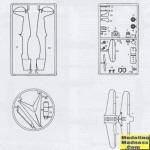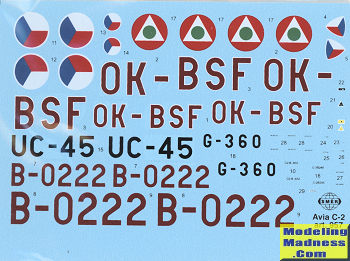
SMER 1/72 Avia C-2
| KIT #: | 0957 |
| PRICE: | $ |
| DECALS: | Three options |
| REVIEWER: | Scott Van Aken |
| NOTES: | Reboxed KP kit |

| HISTORY |
The Arado Ar 96 was a successful single-engine, two -seat advanced trainer used by the German Luftwaffe during and immediately prior to World War II. Designed in 1936 in response to a Reich Air Ministry requirement as a clean, low-wing monoplane of all-metal construction, the Arado trainer was quite modern at the time, using many light alloys. It was designed to fill the gap between the biplanes employed for basic training and the advanced monoplane fighters just entering service, in particular the Messerschmitt Bf 109.
The Arado Ar 96 prototype flew for the first time in 1937, powered by a 179 kW (240 hp) Argus As 10c engine. Over 11,000 were build, most of them by companies other than Arado.
The Ar 96 was used for advanced, night and instrument-flying training. Famously, during the evening of 28 April 1945, pilot Hanna Reitsch and then-Luftwaffe head Generalfeldmarschall Robert Ritter von Greim were flown out of Berlin under Soviet fire in an Arado Ar 96 trainer. The aircraft took off from an improvised airstrip in the Tiergarten, piloted by a Luftwaffe sergeant.
Production was also undertaken by Letov and the Avia factory in occupied Czechoslovakia, where manufacturing continued for some years after the war, being designated the Avia C-2B.
A wooden version, known as the Ar 396, was built in France and was designated the SIPA S.10. Further developments were the SIPA S.11 (armed version), and the SIPA S.12, a metal version; 188 of all versions were produced until 1958. The S.11 was operated with some success in Algeria, carrying machine guns, rockets and light bombs.
| THE KIT |
 A couple of days ago, I built the Heller Ar-96 and thought it was a nice kit
despite its age. So I thought I'd do another in the near future. SMER is a Czech
company that frequently boxes other people's kit and provides superior decals to
the originals so I ordered one from the 'net expecting the Heller kit. SMER has
reboxed a lot of Heller kits. However, when I opened the box it was obvious from
the display stand that this was the KP kit. Now I've not built the KP version so
figured I'd see what this one was like.
A couple of days ago, I built the Heller Ar-96 and thought it was a nice kit
despite its age. So I thought I'd do another in the near future. SMER is a Czech
company that frequently boxes other people's kit and provides superior decals to
the originals so I ordered one from the 'net expecting the Heller kit. SMER has
reboxed a lot of Heller kits. However, when I opened the box it was obvious from
the display stand that this was the KP kit. Now I've not built the KP version so
figured I'd see what this one was like.
In line with the Heller kit it is old school raised panel lines (what few there are). It is difficult to engineer the same plane in different ways so I was expecting things to be rather similar. So they are. The cockpit floor plate has spaces for two seats and control sticks with the roll over assembly being part of the bulkhead behind the pilot. There is an instrument panel for the front seat, but not one for the back. There is a center piece between the two seats so apparently the instruments for the instructor are there in real life.
The wing is a single lower piece with upper halves just like the Heller kit. Unlike the Heller kit, KP's offering has full wheel wells, though they look shallow. The landing gear struts on the KP kit are a step below the Heller offerings but are still fairly nice. Once the wings are done they fit to the bottom of the fuselage and the tailplane slots into the back. This kit offers what looks like a nose gun and a gun camera, the latter just to the right of the front cockpit. The props are pretty similar and this fits onto a front cowling piece that will attach to the front of the fuselage. The canopy is a single piece and somewhat thick.
 Instructions are well drawn with generic color information. For instance they
simply point at the interior as being 'grey'. It is probably RLM 02 or even RLM
66. If you trust warbirds and museum pieces you can find examples on the 'net.
Markings are very nicely done and provide three aluminum painted options. First
is the box art plane from the National Security Corps. Apparently these folks
flew a bunch of different types. The standard markings for the Corps is a red
cowling and spinner, with the leading edges of the wings and tailplanes also in
dark red. Civil registration in red. Next is a Hungarian plane in markings that
I first thought were Lebanese, but apparently these were used in the 1948-49
time period. Fin and tailplanes painted in red, white and green with the red
being outermost. At least during WWII, apparently the tailplanes had the red on
the inner portion. Finally, another Czech option, this time a trainer with the
Central Flying School coded UC-45.
Instructions are well drawn with generic color information. For instance they
simply point at the interior as being 'grey'. It is probably RLM 02 or even RLM
66. If you trust warbirds and museum pieces you can find examples on the 'net.
Markings are very nicely done and provide three aluminum painted options. First
is the box art plane from the National Security Corps. Apparently these folks
flew a bunch of different types. The standard markings for the Corps is a red
cowling and spinner, with the leading edges of the wings and tailplanes also in
dark red. Civil registration in red. Next is a Hungarian plane in markings that
I first thought were Lebanese, but apparently these were used in the 1948-49
time period. Fin and tailplanes painted in red, white and green with the red
being outermost. At least during WWII, apparently the tailplanes had the red on
the inner portion. Finally, another Czech option, this time a trainer with the
Central Flying School coded UC-45.
| CONCLUSIONS |
Generally, unless a kit has visible errors, one can only really tell about a kit by its building, but to me, it seems this one should turn out every bit as nice as the Heller offering. The interesting choice of markings adds to the interest. For those wondering, they also do a boxing of Luftwaffe Ar-96s.
| REFERENCES |
https://en.wikipedia.org/wiki/Arado_Ar_96
June 2019
Copyright ModelingMadness.com. All rights reserved.
If you would like your product reviewed fairly and fairly quickly, please contact the editor or see other details in the Note to Contributors.
Back to the Main Page Back to the Previews Index Page Back to the Review Index Page